Impacts of Climate Change on Hydroclimatic Conditions of U.S. National Forests and Grasslands
Abstract
1. Introduction
2. Materials and Methods
2.1. U.S. National Forests and Grasslands
2.2. Hydroclimatic Projections
2.3. Movements in the Budyko Space
2.4. Changes in Basin Characteristics
3. Results
3.1. Changes in Hydroclimatic Variables
3.2. Movements in the Budyko Space
3.3. Changes in Basin Characteristics
4. Discussion
5. Summary and Conclusions
Supplementary Materials
Author Contributions
Funding
Data Availability Statement
Acknowledgments
Conflicts of Interest
References
- Joyce, L.A.; Blate, G.M.; Littell, J.S.; McNulty, S.G.; Millar, C.I.; Moser, S.C.; Neilson, R.P.; O’Halloran, K.; Peterson, D. Adaptation Options for Climate-Sensitive Ecosystems and Resources. Natl. Serv. Cent. Environ. Publ. 2008, 60, 129. [Google Scholar]
- Bonan, G.B. Forests and climate change: Forcings, feedbacks, and the climate benefits of forests. Science 2008, 320, 1444–1449. [Google Scholar] [CrossRef] [PubMed]
- Duan, K.; Sun, G.; Sun, S.; Caldwell, P.V.; Cohen, E.C.; McNulty, S.G.; Aldridge, H.D.; Zhang, Y. Divergence of ecosystem services in U.S. National Forests and Grasslands under a changing climate. Sci. Rep. 2016, 6, 2–11. [Google Scholar] [CrossRef]
- Yannian, Y. Hydrological effects of forests. Hydrol. Basis Water Resour. Manag. Proc. Symp. Beijing 1990, 197, 413–423. [Google Scholar]
- Astigarraga, J.; Andivia, E.; Zavala, M.A.; Gazol, A.; Cruz-Alonso, V.; Vicente-Serrano, S.M.; Ruiz-Benito, P. Evidence of non-stationary relationships between climate and forest responses: Increased sensitivity to climate change in Iberian forests. Glob. Chang. Biol. 2020, 26, 1–14. [Google Scholar] [CrossRef]
- Allen, C.D.; Macalady, A.K.; Chenchouni, H.; Bachelet, D.; McDowell, N.; Vennetier, M.; Kitzberger, T.; Rigling, A.; Breshears, D.D.; Hogg, E.H.T.; et al. A global overview of drought and heat-induced tree mortality reveals emerging climate change risks for forests. For. Ecol. Manag. 2010, 259, 660–684. [Google Scholar] [CrossRef]
- Jump, A.S.; Ruiz-Benito, P.; Greenwood, S.; Allen, C.D.; Kitzberger, T.; Fensham, R.; Martínez-Vilalta, J.; Lloret, F. Structural overshoot of tree growth with climate variability and the global spectrum of drought-induced forest dieback. Glob. Chang. Biol. 2017, 23, 3742–3757. [Google Scholar] [CrossRef]
- McIntyre, P.J.; Thorne, J.H.; Dolanc, C.R.; Flint, A.L.; Flint, L.E.; Kelly, M.; Ackerly, D.D. Twentieth-century shifts in forest structure in California: Denser forests, smaller trees, and increased dominance of oaks. Proc. Natl. Acad. Sci. USA 2015, 112, 1458–1463. [Google Scholar] [CrossRef]
- Jeong, J.H.; Resop, J.P.; Mueller, N.D.; Fleisher, D.H.; Yun, K.; Butler, E.E.; Timlin, D.J.; Shim, K.M.; Gerber, J.S.; Reddy, V.R.; et al. Random forests for global and regional crop yield predictions. PLoS ONE 2016, 11, 1–15. [Google Scholar] [CrossRef]
- Esquivel-Muelbert, A.; Baker, T.R.; Dexter, K.G.; Lewis, S.L.; Brienen, R.J.W.; Feldpausch, T.R.; Lloyd, J.; Monteagudo-Mendoza, A.; Arroyo, L.; Álvarez-Dávila, E.; et al. Compositional response of Amazon forests to climate change. Glob. Chang. Biol. 2019, 25, 39–56. [Google Scholar] [CrossRef]
- Peterson, D.L.; Millar, C.I.; Joyce, L.A.; Furniss, M.J.; Halofsky, J.E.; Neilson, R.P.; Morelli, T.L. Responding to climate change in national forests: A guidebook for developing adaptation options. USDA For. Serv. Gen. Tech. Rep. PNW-GTR 2011, 1–99. [Google Scholar] [CrossRef]
- Westerling, A.L.; Hidalgo, H.G.; Cayan, D.R.; Swetnam, T.W. Warming and earlier spring increase Western U.S. forest wildfire activity. Science 2006, 313, 940–943. [Google Scholar] [CrossRef] [PubMed]
- Weed, A.S.; Ayres, M.P.; Hicke, J.A. Consequences of climate change for biotic disturbances in North American forests. Ecol. Monogr. 2013, 83, 441–470. [Google Scholar] [CrossRef]
- Rehfeldt, G.E.; Ferguson, D.E.; Crookston, N.L. Aspen, climate, and sudden decline in western USA. For. Ecol. Manag. 2009, 258, 2353–2364. [Google Scholar] [CrossRef]
- Fekety, P.A.; Crookston, N.L.; Hudak, A.T.; Filippelli, S.K.; Vogeler, J.C.; Falkowski, M.J. Hundred year projected carbon loads and species compositions for four National Forests in the northwestern USA. Carbon Balance Manag. 2020, 15, 1–14. [Google Scholar] [CrossRef]
- Littell, J.S.; Peterson, D.L.; Millar, C.I.; O’Halloran, K.A. U.S. National Forests adapt to climate change through Science-Management partnerships. Clim. Chang. 2012, 110, 269–296. [Google Scholar] [CrossRef]
- Van der Velde, Y.; Vercauteren, N.; Jaramillo, F.; Dekker, S.C.; Destouni, G.; Lyon, S.W. Exploring hydroclimatic change disparity via the Budyko framework. Hydrol. Process. 2014, 28, 4110–4118. [Google Scholar] [CrossRef]
- Piemontese, L.; Fetzer, I.; Rockström, J.; Jaramillo, F. Future Hydroclimatic Impacts on Africa: Beyond the Paris Agreement. Earth’s Future 2019, 7, 748–761. [Google Scholar] [CrossRef]
- Zaninelli, P.G.; Menéndez, C.G.; Falco, M.; López-Franca, N.; Carril, A.F. Future hydroclimatological changes in South America based on an ensemble of regional climate models. Clim. Dyn. 2019, 52, 819–830. [Google Scholar] [CrossRef]
- Heidari, H.; Arabi, M.; Warziniack, T.; Kao, S.C. Assessing Shifts in Regional Hydroclimatic Conditions of U.S. River Basins in Response to Climate Change over the 21st Century. Earth’s Future 2020, 8, 1–14. [Google Scholar] [CrossRef]
- McKee, T.B.; Doesken, J.J.; Klesit, J. Analysis of Standardized Precipitation Index (SPI) data for drought assessment. Water 1993, 26, 1–72. [Google Scholar] [CrossRef]
- Yang, D.; Sun, F.; Liu, Z.; Cong, Z.; Lei, Z. Interpreting the complementary relationship in non-humid environments based on the Budyko and Penman hypotheses. Geophys. Res. Lett. 2006, 33, 1–5. [Google Scholar] [CrossRef]
- Reis, D.S.; Cerqueira, C.M.; Vieira, R.F.; Martins, E.S. Budyko’s framework and climate elasticity concept in the estimation of climate change impacts on the long-term mean annual streamflow. In Proceedings of the World Environmental and Water Resources Congress 2013 Showcasing the Future, Cincinnati, OH, USA, 19–23 May 2013; pp. 1110–1120. [Google Scholar] [CrossRef]
- Rouholahnejad, F.E.; Kirchner, J.W. A Budyko framework for estimating how spatial heterogeneity and lateral moisture redistribution affect average evapotranspiration rates as seen from the atmosphere. Hydrol. Earth Syst. Sci. 2017, 21, 217–233. [Google Scholar] [CrossRef]
- Zhang, Q.; Liu, J.; Singh, V.P.; Shi, P.; Sun, P. Hydrological responses to climatic changes in the Yellow River basin, China: Climatic elasticity and streamflow prediction. J. Hydrol. 2017, 554, 635–645. [Google Scholar] [CrossRef]
- Deng, W.; Song, J.; Bai, H.; He, Y.; Yu, M.; Wang, H.; Cheng, D. Analyzing the impacts of climate variability and land surface changes on the annual water-energy balance in the Weihe River Basin of China. Water 2018, 10, 1792. [Google Scholar] [CrossRef]
- Xing, W.; Wang, W.; Shao, Q.; Yong, B.; Liu, C.; Feng, X.; Dong, Q. Estimating monthly evapotranspiration by assimilating remotely sensed water storage data into the extended Budyko framework across different climatic regions. J. Hydrol. 2018, 567, 684–695. [Google Scholar] [CrossRef]
- Abera, W.; Tamene, L.; Abegaz, A.; Solomon, D. Understanding climate and land surface changes impact on water resources using Budyko framework and remote sensing data in Ethiopia. J. Arid Environ. 2019, 167, 56–64. [Google Scholar] [CrossRef]
- Zhang, L.; Hickel, K.; Dawes, W.R.; Chiew, F.H.S.; Western, A.W.; Briggs, P.R. A rational function approach for estimating mean annual evapotranspiration. Water Resour. Res. 2004, 40, 1–14. [Google Scholar] [CrossRef]
- Abatzoglou, J.T.; Brown, T.J. A comparison of statistical downscaling methods suited for wildfire applications. Int. J. Climatol. 2012, 32, 772–780. [Google Scholar] [CrossRef]
- Liang, X.; Lettenmaier, D.P.; Wood, E.F.; Burges, S.J. A simple hydrologically based model of land surface water and energy fluxes for general circulation models. J. Geophys. Res. 1994, 99, 14415–14428. [Google Scholar] [CrossRef]
- Thornton, P.E.; Running, S.W.; White, M.A. Generating surfaces of daily meteorological variables over large regions of complex terrain. J. Hydrol. 1997, 190, 214–251. [Google Scholar] [CrossRef]
- Daly, C.; Halbleib, M.; Smith, J.I.; Gibson, W.P.; Doggett, M.K.; Taylor, G.H.; Curtis, J.; Pasteris, P.P. Physiographically sensitive mapping of climatological temperature and precipitation across the conterminous United States. Int. J. Climatol. 2008, 28, 2031–2064. [Google Scholar] [CrossRef]
- Mesinger, F.; DiMego, G.; Kalnay, E.; Mitchell, K.; Shafran, P.C.; Ebisuzaki, W.; Jović, D.; Woollen, J.; Rogers, E.; Berbery, E.H.; et al. North American regional reanalysis. Bull. Am. Meteorol. Soc. 2006, 87, 343–360. [Google Scholar] [CrossRef]
- Oubeidillah, A.A.; Kao, S.C.; Ashfaq, M.; Naz, B.S.; Tootle, G. A large-scale, high-resolution hydrological model parameter data set for climate change impact assessment for the conterminous US. Hydrol. Earth Syst. Sci. 2014, 18, 67–84. [Google Scholar] [CrossRef]
- Naz, B.S.; Kao, S.C.; Ashfaq, M.; Rastogi, D.; Mei, R.; Bowling, L.C. Regional hydrologic response to climate change in the conterminous United States using high-resolution hydroclimate simulations. Glob. Planet. Chang. 2016, 143, 100–117. [Google Scholar] [CrossRef]
- Joyce, L.; Coulson, D. Climate Scenarios and Projections, A Technical Document Supporting the USDA Forest Service 2020 RPA Assessment; General Technical Report RMRS-GTR-413; U.S. Department of Agriculture, Forest Service, Rocky Mountain Research Station: Fort Collins, CO, USA, 2020. [Google Scholar] [CrossRef]
- Deser, C.; Hurrell, J.W.; Phillips, A.S. The role of the North Atlantic Oscillation in European climate projections. Clim. Dyn. 2017, 49, 3141–3157. [Google Scholar] [CrossRef]
- Deser, C.; Knutti, R.; Solomon, S.; Phillips, A.S. Communication of the role of natural variability in future North American climate. Nat. Clim. Chang. 2012, 2, 775–779. [Google Scholar] [CrossRef]
- Kjellström, E.; Thejll, P.; Rummukainen, M.; Christensen, J.; Boberg, F.; Christensen, O.; Fox Maule, C. Emerging regional climate change signals for Europe under varying large-scale circulation conditions. Clim. Res. 2013, 56, 103–119. [Google Scholar] [CrossRef]
- Cherkauer, K.A.; Lettenmaier, D.P. Simulation of spatial variability in snow and frozen soil. J. Geophys. Res. Atmos. 2003, 108, 1–14. [Google Scholar] [CrossRef]
- Andreadis, K.M.; Lettenmaier, D.P. Trends in 20th century drought over the continental United States. Geophys. Res. Lett. 2006, 33, 1–4. [Google Scholar] [CrossRef]
- Demaria, E.M.; Nijssen, B.; Wagener, T. Monte Carlo sensitivity analysis of land surface parameters using the Variable Infiltration Capacity model. J. Geophys. Res. Atmos. 2007, 112, D11. [Google Scholar] [CrossRef]
- Brakebill, J.W.; Wolock, D.M.; Terziotti, S.E. Digital Hydrologic Networks Supporting Applications Related to Spatially Referenced Regression Modeling. JAWRA J. Am. Water Resour. Assoc. 2011, 47, 916–932. [Google Scholar] [CrossRef][Green Version]
- Budyko, M.I. Climate and Life; International Geophysical Series; New York Academic Press: Cambridge, MA, USA, 1974; Volume 18. [Google Scholar]
- Budyko, M.I. The Earth’s Climate: Past and Future; International Geophysical Series; New York Academic Press: Cambridge, MA, USA, 1982; Volume 29. [Google Scholar]
- Heidari, H.; Arabi, M.; Ghanbari, M.; Warziniack, T. A Probabilistic Approach for Characterization of Sub-Annual Socioeconomic Drought Intensity-Duration-Frequency (IDF) Relationships in a Changing Environment. Water 2020, 12, 1522. [Google Scholar] [CrossRef]
- Ghanbari, M.; Arabi, M.; Obeysekera, J.; Sweet, W. A Coherent Statistical Model for Coastal Flood Frequency Analysis Under Nonstationary Sea Level Conditions. Earth’s Future 2019, 7, 162–177. [Google Scholar] [CrossRef]
- Ghanbari, M.; Arabi, M.; Obeysekera, J. Chronic and Acute Coastal Flood Risks to Assets and Communities in Southeast Florida. J. Water Resour. Plan. Manag. 2020, 146, 1–10. [Google Scholar] [CrossRef]
- Hemmati, M.; Ellingwood, B.R.; Mahmoud, H.N. The Role of Urban Growth in Resilience of Communities Under Flood Risk. Earth’s Future 2020, 8, 1–14. [Google Scholar] [CrossRef] [PubMed]
- Yue, X.; Mickley, L.J.; Logan, J.A.; Kaplan, J.O. Ensemble projections of wildfire activity and carbonaceous aerosol concentrations over the western United States in the mid-21st century. Atmos. Environ. 2013, 77, 767–780. [Google Scholar] [CrossRef]
- Coe, M.T.; Latrubesse, E.M.; Ferreira, M.E.; Amsler, M.L. The effects of deforestation and climate variability on the streamflow of the Araguaia River, Brazil. Biogeochemistry 2011, 105, 119–131. [Google Scholar] [CrossRef]
- Zhang, M.; Wei, X. The effects of cumulative forest disturbance on streamflow in a large watershed in the central interior of British Columbia, Canada. Hydrol. Earth Syst. Sci. 2012, 16, 2021–2034. [Google Scholar] [CrossRef]
- Zhao, F.; Xu, Z.; Zhang, L.; Zuo, D. Streamflow response to climate variability and human activities in the upper catchment of the Yellow River Basin. Sci. China Ser. E-Technol. Sci. 2009, 52, 3249–3256. [Google Scholar] [CrossRef]
- Zhou, S.; Yu, B.; Huang, Y.; Wang, G. The complementary relationship and generation of the Budyko functions. Geophys. Res. Lett. 2015, 42, 1781–1790. [Google Scholar] [CrossRef]
- Zhou, G.; Wei, X.; Chen, X.; Zhou, P.; Liu, X.; Xiao, Y.; Sun, G.; Scott, D.F.; Zhou, S.; Han, L.; et al. Global pattern for the effect of climate and land cover on water yield. Nat. Commun. 2015, 6, 1–9. [Google Scholar] [CrossRef] [PubMed]
- Li, Y.; Liu, C.; Yu, W.; Tian, D.; Bai, P. Response of streamflow to environmental changes: A Budyko-type analysis based on 144 river basins over China. Sci. Total Environ. 2019, 664, 824–833. [Google Scholar] [CrossRef] [PubMed]
- Destouni, G.; Jaramillo, F.; Prieto, C. Hydroclimatic shifts driven by human water use for food and energy production. Nat. Clim. Chang. 2013, 3, 213–217. [Google Scholar] [CrossRef]
- Collins, M.; Knutti, R.; Arblaster, J.; Dufresne, J.-L.; Fichefet, T.; Friedlingstein, P.; Gao, X.; Gutowski, W.J.; Johns, T.; Krinner, G.; et al. Long-Term Climate Change: Projections, Commitments and Irreversibility. In Climate Change 2013-The Physical Science Basis Contribution of Working Group I to the Fifth Assessment Report of the Intergovernmental Panel on Climate Change; Stocker, T.F., Qin, D., Plattner, G.-K., Tignor, M., Allen, S.K., Boschung, J., Nauels, A., Xia, Y., Bex, V., Midgley, P.M., Eds.; Cambridge University: Cambridge, UK, 2013; ISBN 9781107057. [Google Scholar]
- Wyard, C.; Scholzen, C.; Doutreloup, S.; Hallot, É.; Fettweis, X. Future evolution of the hydroclimatic conditions favouring floods in the south-east of Belgium by 2100 using a regional climate model. Int. J. Climatol. 2020, 41, 1–16. [Google Scholar] [CrossRef]
- Gharari, S.; Clark, M.P.; Mizukami, N.; Wong, J.S.; Pietroniro, A.; Wheater, H.S. Improving the Representation of Subsurface Water Movement in Land Models. J. Hydrometeorol. 2019, 20, 2401–2418. [Google Scholar] [CrossRef]
- Gharari, S.; Clark, M.P.; Mizukami, N.; Knoben, W.J.M.; Wong, J.S.; Pietroniro, A. Flexible vector-based spatial configurations in land models. Hydrol. Earth Syst. Sci. 2020, 24, 5953–5971. [Google Scholar] [CrossRef]
- Melsen, L.; Teuling, A.; Torfs, P.; Zappa, M.; Mizukami, N.; Clark, M.; Uijlenhoet, R. Representation of spatial and temporal variability in large-domain hydrological models: Case study for a mesoscale pre-Alpine basin. Hydrol. Earth Syst. Sci. 2016, 20, 2207–2226. [Google Scholar] [CrossRef]
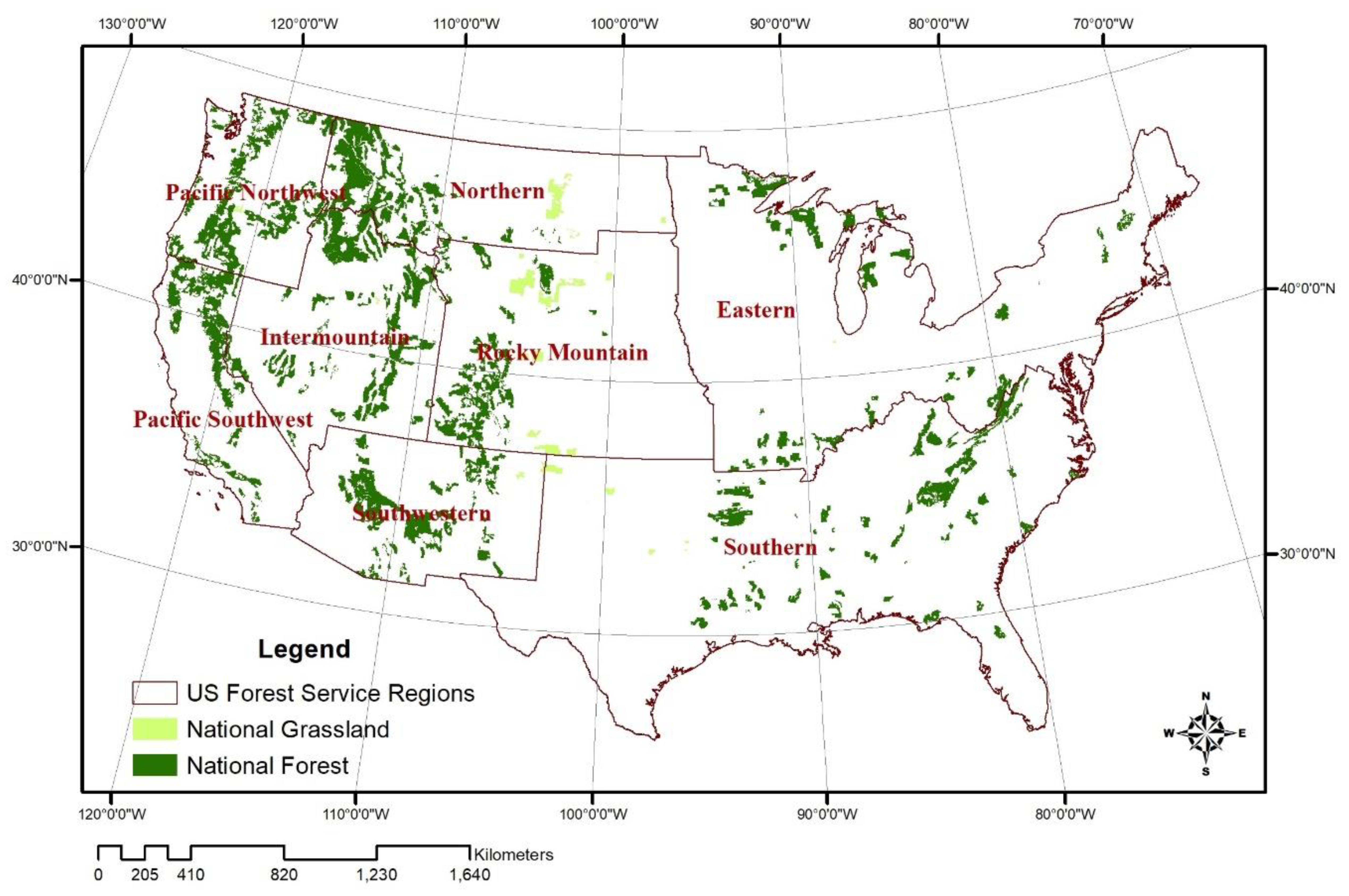
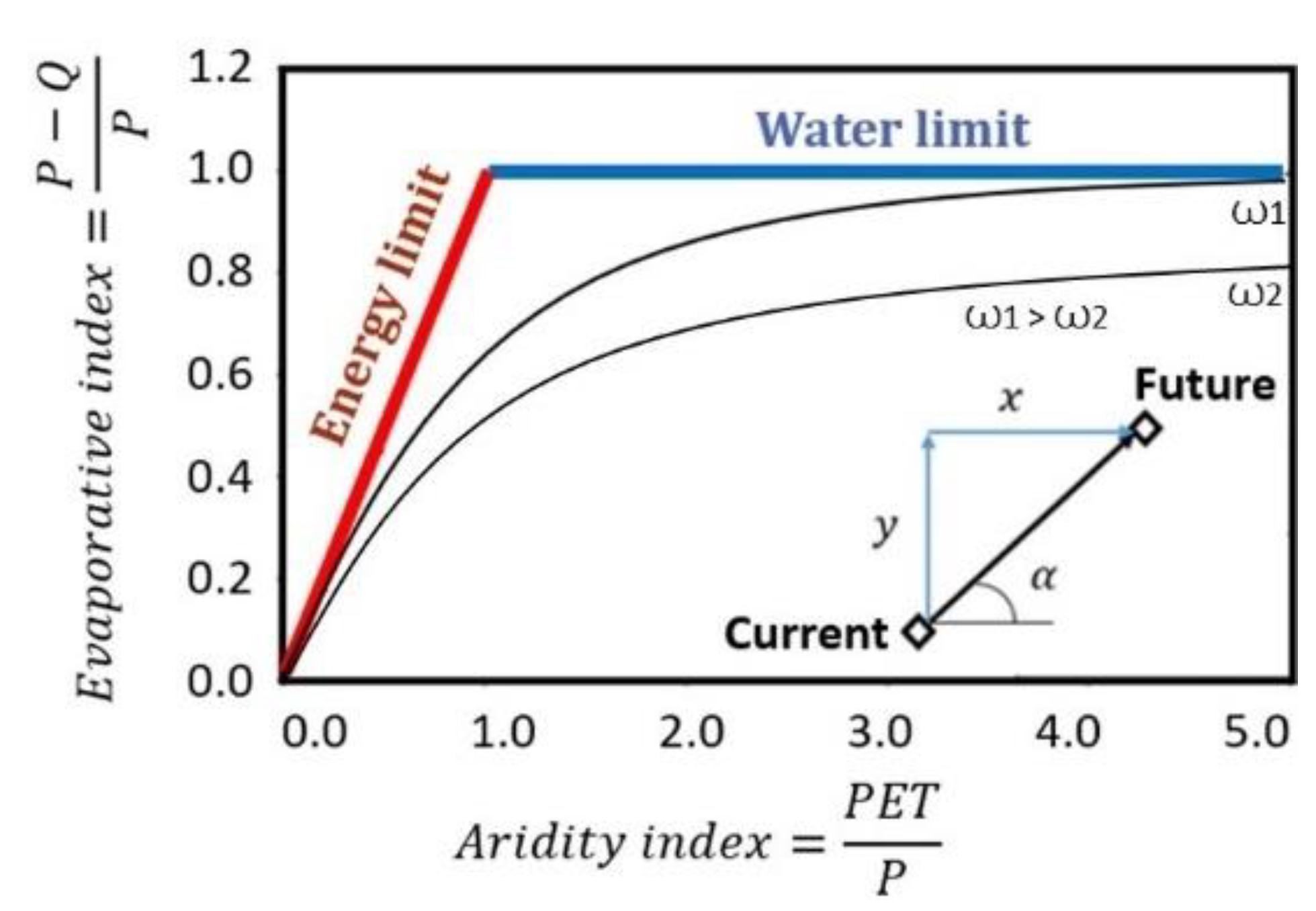
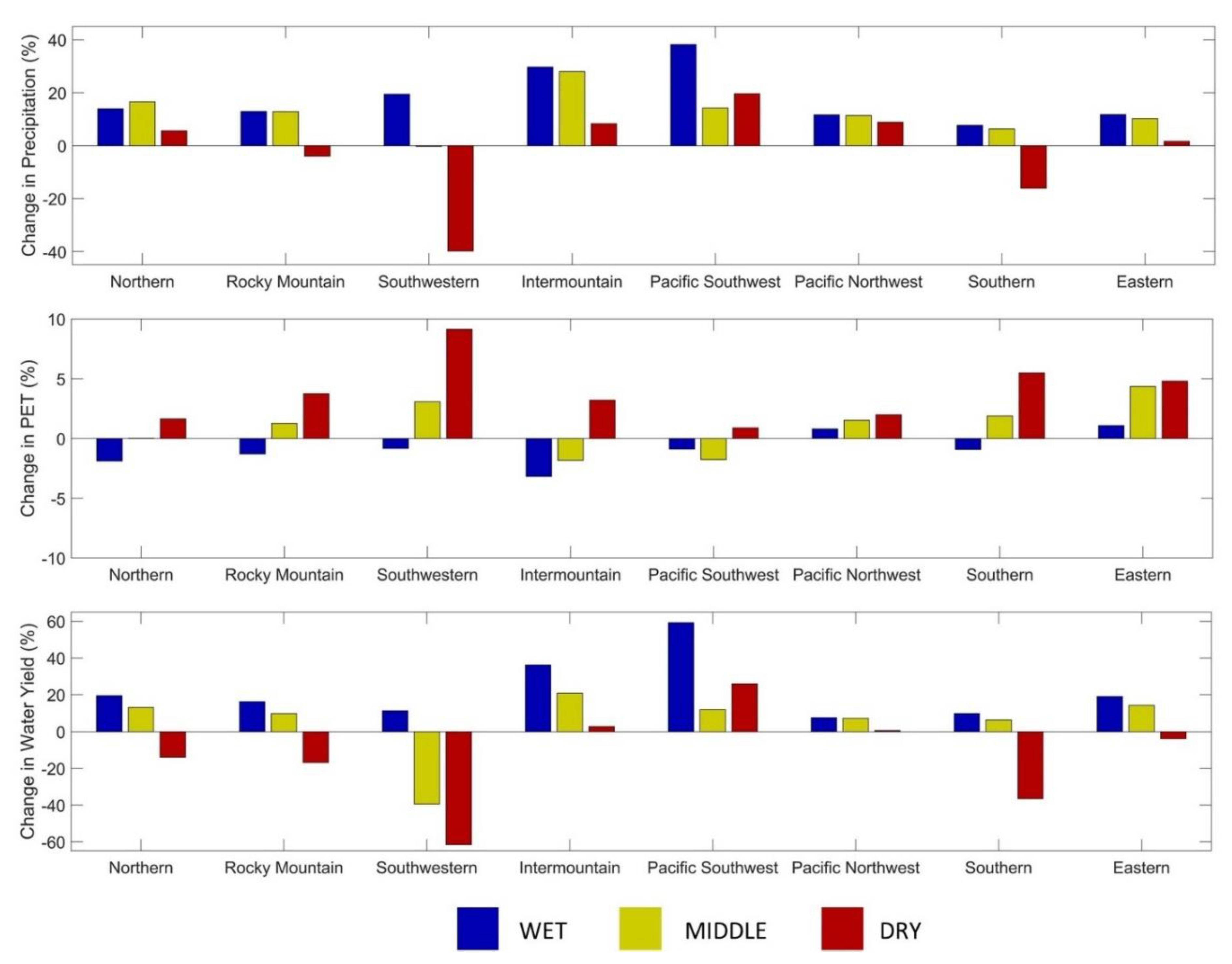
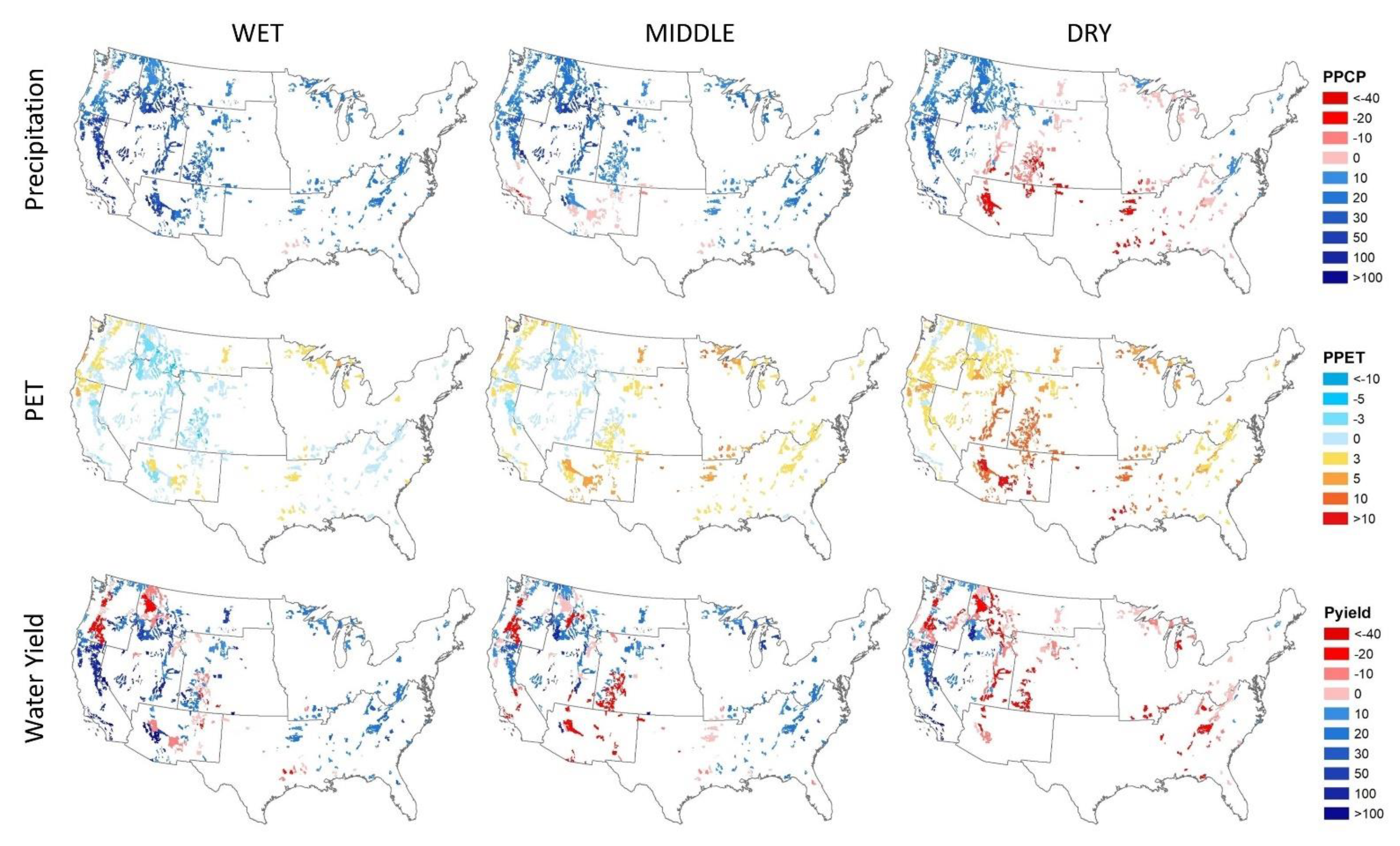

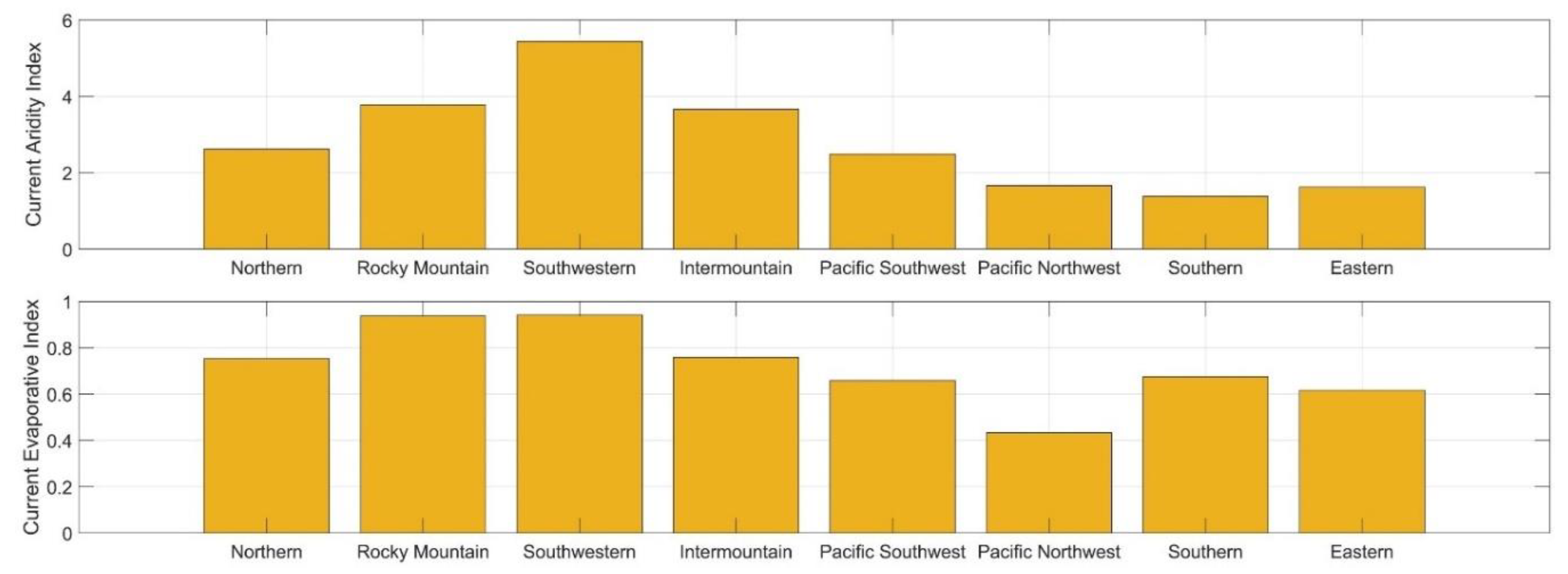
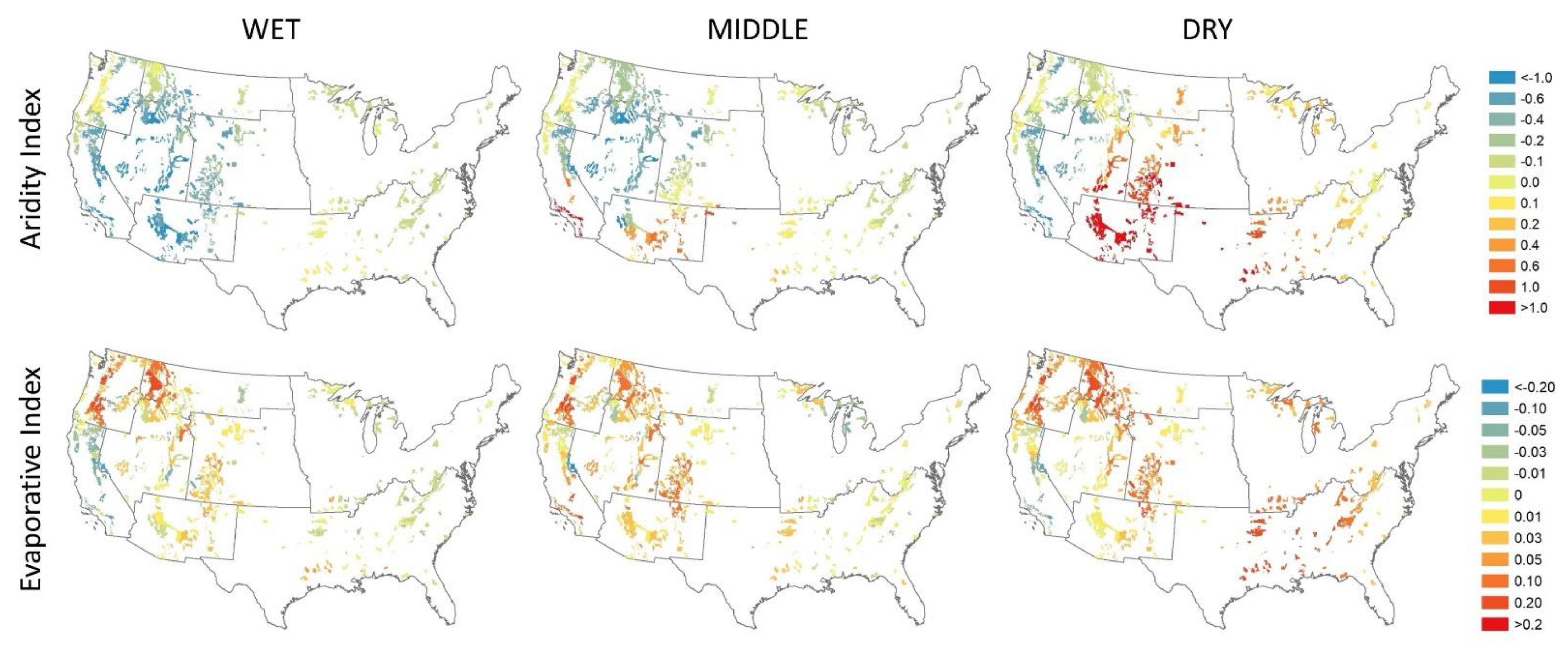

| WET | DRY | MIDDLE | |
|---|---|---|---|
| Name | CNRM-CM5 (RCP 8.5) | IPSL-CM5A-MR (RCP 8.5) | NorESM1-M (RCP 8.5) |
| Model Agency | National Centre of Meteorological Research, France | Institute Pierre Simon Laplace, France | Norwegian Climate Center, Norway |
| Type | PCP (mm) | YIELD (mm) | PET (mm) |
|---|---|---|---|
| NFs | 909 | 400 | 1533 |
| NGs | 426 | 25 | 1523 |
| CONUS | 876 | 301 | 1617 |
| Climate Models | Type | PCP (%) | YIELD (%) | PET (%) |
|---|---|---|---|---|
| MIDDLE | NFs | 13.51 | 8.05 | 0.80 |
| NGs | 11.41 | 12.47 | 2.19 | |
| CONUS | 9.11 | 12.26 | 2.41 | |
| DRY | NFs | 1.98 | −8.76 | 3.34 |
| NGs | −2.81 | −12.20 | 3.62 | |
| CONUS | −6.63 | −12.46 | 5.01 | |
| WET | NFs | 18.22 | 21.38 | −0.92 |
| NGs | 10.63 | 18.99 | −0.30 | |
| CONUS | 15.86 | 36.87 | −0.48 |
| Types | Current | WET | MID | DRY |
|---|---|---|---|---|
| Forest | 1.82 | 1.924 | 1.939 | 1.927 |
| Grassland | 2.95 | 3.049 | 3.061 | 2.949 |
| CONUS | 2.135 | 2.162 | 2.159 | 2.133 |
| Forest Service Region | Current | WET | MIDDLE | DRY |
|---|---|---|---|---|
| Northern | 1.80 | 1.91 | 1.92 | 1.95 |
| Rocky Mountain | 2.41 | 2.49 | 2.56 | 2.48 |
| Southwestern | 2.21 | 2.36 | 2.40 | 2.11 |
| Intermountain | 1.68 | 1.79 | 1.82 | 1.73 |
| Pacific Southwest | 1.61 | 1.66 | 1.67 | 1.65 |
| Pacific Northwest | 1.38 | 1.44 | 1.43 | 1.45 |
| Southern | 2.00 | 2.05 | 2.01 | 2.04 |
| Eastern | 1.71 | 1.71 | 1.71 | 1.74 |
Publisher’s Note: MDPI stays neutral with regard to jurisdictional claims in published maps and institutional affiliations. |
© 2021 by the authors. Licensee MDPI, Basel, Switzerland. This article is an open access article distributed under the terms and conditions of the Creative Commons Attribution (CC BY) license (http://creativecommons.org/licenses/by/4.0/).
Share and Cite
Heidari, H.; Warziniack, T.; Brown, T.C.; Arabi, M. Impacts of Climate Change on Hydroclimatic Conditions of U.S. National Forests and Grasslands. Forests 2021, 12, 139. https://doi.org/10.3390/f12020139
Heidari H, Warziniack T, Brown TC, Arabi M. Impacts of Climate Change on Hydroclimatic Conditions of U.S. National Forests and Grasslands. Forests. 2021; 12(2):139. https://doi.org/10.3390/f12020139
Chicago/Turabian StyleHeidari, Hadi, Travis Warziniack, Thomas C. Brown, and Mazdak Arabi. 2021. "Impacts of Climate Change on Hydroclimatic Conditions of U.S. National Forests and Grasslands" Forests 12, no. 2: 139. https://doi.org/10.3390/f12020139
APA StyleHeidari, H., Warziniack, T., Brown, T. C., & Arabi, M. (2021). Impacts of Climate Change on Hydroclimatic Conditions of U.S. National Forests and Grasslands. Forests, 12(2), 139. https://doi.org/10.3390/f12020139






